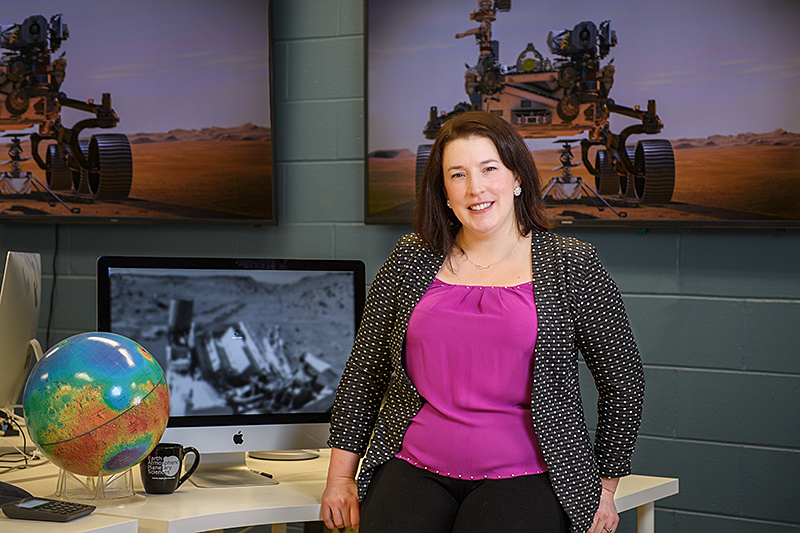February 14, 2022
Purdue professor, Perseverance member preparing for year two as rover mission reaches landing anniversary

Briony Horgan, Purdue University associate professor of planetary science, sits inside the Mars Rover Operations Center in Purdue’s Delon and Elizabeth Hampton Hall of Civil Engineering. Horgan is part of the Mars rover mission approaching its first year on the red planet. (Purdue University photo/Rebecca McElhoe)
WEST LAFAYETTE, Ind. — A year of helping direct the Perseverance rover across the Mars terrain has Purdue University’s Briony Horgan and the rover team on the doorstep of the mission goal.
Friday (Feb. 18) will mark one year since the rover landed on the red planet following a seven-month, 300-million-mile flight through space for the NASA project.
The mission team opted to land the rover in Jezero Crater because of a dry lake and river delta located there. The team expects to reach the delta by spring and begin the key objective of searching for signs of ancient microbial life by examining the planet’s geology.
“We’ll spend most of the next year on the delta, exploring this ancient lake and river environment and looking for signs of ancient life-like organic material and signs of microbes,” said Horgan, associate professor of planetary science in Purdue’s Department of Earth, Atmospheric, and Planetary Sciences in the College of Science.
Watch video of Horgan as she talks about the first year of the mission.
Horgan is long-term planner as part of the science leadership team for Perseverance, helping guide the mission strategy and scientific investigations. She discusses the rover mission on an episode of the “This is Purdue” podcast.
The mission will have collected four unique rock samples from Mars. More samples are expected as the rover heads onto the delta.
“By analyzing these samples back on Earth, we can actually figure out when the delta was there and when there was water in the crater,” Horgan said. “That’s a really big question because we only have estimates for when we think Mars was wet and was habitable. We really don’t know for sure.”
Horgan has been involved with several aspects of this mission. She led mineralogy research using satellite data before landing, and her team produced one of the major results on the location that contributed to NASA’s selection of Jezero Crater.
The mission is intended to last three years. Horgan said that after the three-year point, the hope is Perseverance will continue outside Jezero Crater for as long as possible.
Visitors to campus are required to wear masks in indoor settings and follow Protect Purdue guidelines.
About Purdue University
Purdue University is a top public research institution developing practical solutions to today’s toughest challenges. Ranked in each of the last four years as one of the 10 Most Innovative universities in the United States by U.S. News & World Report, Purdue delivers world-changing research and out-of-this-world discovery. Committed to hands-on and online, real-world learning, Purdue offers a transformative education to all. Committed to affordability and accessibility, Purdue has frozen tuition and most fees at 2012-13 levels, enabling more students than ever to graduate debt-free. See how Purdue never stops in the persistent pursuit of the next giant leap at https://purdue.edu/.
Writer, Media contact: Brian Huchel, bhuchel@purdue.edu
Source: Briony Horgan, briony@purdue.edu, @ironywithab
Note to journalists: Video clips and a photo of Briony Horgan are available on Google Drive. Journalists visiting campus should follow visitor health guidelines.

